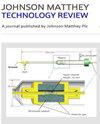钯在有机合成中的可持续性研究
IF 2
4区 化学
Q4 CHEMISTRY, PHYSICAL
引用次数: 0
摘要
随便问一个有资格的有机化学家,当今哪种金属在合成有机化学领域占据着至高无上的地位,大多数人(如果不是全部的话)都会很快认定钯是显而易见的赢家。但这种柔软的银白色金属只是组成铂族金属(pgms)的六种金属之一,铂族金属还包括Ru、Os、Pt、Rh和Ir。根据美国化学学会绿色化学研究所的说法,1pd“可用性有限……”;其他五种也濒临灭绝,因为它们“使用增加的威胁越来越大”。简而言之,他们或多或少都处于危险之中。虽然通常基于成本,Os甚至Ru都不被认为是“珍贵的”,但Pt和Pd当然都是“昂贵的”,而Ir,尤其是Rh,则是边缘性的,通常用于催化剂负载必须非常低的反应。在过去的几年里,钯的价格偶尔会跃升至3000美元/金衡盎司(见下图),即使在今天,钯的价值仍然高于金(< 2000美元/金衡盎司)。这对pgms的短期预后有什么影响,更不用说长期可用性的前景了?我们知道地球上的这些特殊资源是有限的,我们怎么能以“一切照旧”的心态继续下去呢?如果仅仅从价格上看,我们不是已经处于危机模式了吗?钯可能至少在纸面上为一个重要的合成问题提供了解决方案,但在实验室中使用它根本负担不起?对于许多生产关键中间体的cmo来说,时机已经到来。现在该做什么?本文章由计算机程序翻译,如有差异,请以英文原文为准。
On the Sustainability of Palladium in Organic Synthesis: A Perspective
Ask any card-carrying organic chemist which metal reigns supreme today in synthetic organic chemistry and most, if not all, will quickly identify palladium as the clear winner. But this soft, silver-white metal is only one of six that make up the platinum group metals (pgms), which also include Ru, Os, Pt, Rh, and Ir. According to the ACS Green Chemistry Institute,1 Pd has “limited availability…”; the other five are also endangered, given their “rising threat from increased use.” In brief, they are, in one way or another, all at risk. And while neither Os nor even Ru is considered “precious” usually based on cost, both Pt and Pd are certainly “expensive”, while Ir, and especially Rh, are borderline prohibitive, typically being reserved for reactions where catalyst loadings must be very low. During the past few years, the price of Pd has jumped on occasion to >$3000/Troy ounce (vide infra), and even today remains more valued than is Au (<$2000/Troy ounce). What does this suggest regarding the prognosis for pgms even in the short term, let alone the prospects for long term availability? How can we continue today with a “business as usual” mentality, knowing that these particular resources on the planet are finite? Are we not already operating in crisis mode, if only on the basis of price, where palladium may provide, at least on paper, the solution to an important synthetic problem but its use in the lab is simply unaffordable? For many CMOs that make crucial intermediates, that time is already here. What now?
求助全文
通过发布文献求助,成功后即可免费获取论文全文。
去求助
来源期刊

Johnson Matthey Technology Review
CHEMISTRY, PHYSICAL-
CiteScore
4.30
自引率
4.30%
发文量
48
审稿时长
12 weeks
期刊介绍:
Johnson Matthey Technology Review publishes articles, reviews and short reports on science enabling cleaner air, good health and efficient use of natural resources. Areas of application and fundamental science will be considered in the fields of:Advanced materials[...]Catalysis[...][...]Characterisation[...]Electrochemistry[...]Emissions control[...]Fine and speciality chemicals[...]Historical[...]Industrial processes[...]Materials and metallurgy[...]Modelling[...]PGM and specialist metallurgy[...]Pharmaceutical and medical science[...]Surface chemistry and coatings[...]Sustainable technologies.
 求助内容:
求助内容: 应助结果提醒方式:
应助结果提醒方式:


